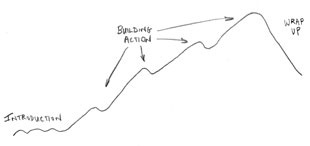Blog
Subscribe
Join over 5,000 people who receive the Anecdotally newsletter—and receive our free ebook Character Trumps Credentials.
Categories
- Anecdotes
- Business storytelling
- Collaboration
- Communication
- Corporate Storytelling
- Culture
- Decision-making
- Employee Engagement
- Events
- Fun
- Insight
- Leadership Posts
- News
- Podcast
- Selling
- Strategy
Archives
- March 2024
- December 2023
- November 2023
- October 2023
- September 2023
- August 2023
- July 2023
- June 2023
- May 2023
- April 2023
Years
Endings are important for how we remember experiences
Daniel Kahneman, the founder of behavioural economics and winner of the Nobel prize in Economics, tell this story in a recent TED talk.
A friend was recently listening to a recording of a beautiful symphony and then at the end of the recording there was a terrible screeching noise. “It ruined the whole experience for me,” he said.
Of course the screeching didn’t ruin his whole experience because he had 20 minutes or so listening to a beautiful symphony. It did, however, ruin his memory of the experience.
Endings are important. Kahneman describes Dan Ariely research1 on how people perceive pain when they have a colonoscopy.
Check out these two graphs Kahneman showed in his TED talk. They report two patients’ experience of pain during a colonoscopy. The second patient clearly endured more pain over a longer period. Interestingly, when ask to report on their memory of the experience the second patient remembered it to be less painful than the first. Ariely’s research concludes that people remember an experience based on what happens as the end, especially if it’s trending in a direction (such as, to lower pain).

So it’s important to focus on the end. We remember the whole in terms of what happens at the end. With the colonoscopy research they found that just leaving in the tube for longer and not wiggling around too much gave people a happier ending.
It’s no coincidence then that a common plot structure is one where the story builds to a strong ending.

You can use this type of plot structure to plan and deliver a presentation so everyone remembers the experience. Of course a good memory of the event happens when the last thing you did is satisfying.
1. Ariely, D. 1998, ‘Combining Experiences Over Time: The Effects of Duration, Intensity Changes and On-Line Measurements on Retrospective Pain Evaluations’, Journal of Behavioral Decision Making, vol. 11, pp. 19-45.
About Shawn Callahan
Shawn, author of Putting Stories to Work, is one of the world's leading business storytelling consultants. He helps executive teams find and tell the story of their strategy. When he is not working on strategy communication, Shawn is helping leaders find and tell business stories to engage, to influence and to inspire. Shawn works with Global 1000 companies including Shell, IBM, SAP, Bayer, Microsoft & Danone. Connect with Shawn on:
Comments
Comments are closed.
Shawn,
This post was very thought provoking. I looked at the video, but you had captured the essence of it in your post. I’ll remember your advice at the end to end a presentation on the high side
Nancy